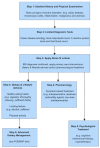The Dietary Management of Patients with Irritable Bowel Syndrome: A Narrative Review of the Existing and Emerging Evidence
- PMID: 31505870
- PMCID: PMC6770052
- DOI: 10.3390/nu11092162
The Dietary Management of Patients with Irritable Bowel Syndrome: A Narrative Review of the Existing and Emerging Evidence
Abstract
Even though irritable bowel syndrome (IBS) has been known for more than 150 years, it still remains one of the research challenges of the 21st century. According to the current diagnostic Rome IV criteria, IBS is characterized by abdominal pain associated with defecation and/or a change in bowel habit, in the absence of detectable organic causes. Symptoms interfere with the daily life of patients, reduce health-related quality of life and lower the work productivity. Despite the high prevalence of approximately 10%, its pathophysiology is only partly understood and seems multifactorial. However, many patients report symptoms to be meal-related and certain ingested foods may generate an exaggerated gastrointestinal response. Patients tend to avoid and even exclude certain food products to relieve their symptoms, which could affect nutritional quality. We performed a narrative paper review of the existing and emerging evidence regarding dietary management of IBS patients, with the aim to enhance our understanding of how to move towards an individualized dietary approach for IBS patients in the near future.
Keywords: dietary fiber; dietary management; exclusion diets; gluten-free diet; irritable bowel syndrome; lactose-free diet; low FODMAP diet.
Conflict of interest statement
The authors declare no conflict of interest.
Figures







References
-
- Sperber A.D., Dumitrascu D., Fucudo S., Gerson C., Ghoshal U.C., Gwee K.A., Hungin A.P.S., Kang J.Y., Minhu C., Schmulson M., et al. The global prevalence of IBS in adults remains elusive due to the heterogeneity of studies: A Rome Foundation working team literature review. Gut. 2017;66:1075–1082. doi: 10.1136/gutjnl-2015-311240. - DOI - PubMed
Publication types
MeSH terms
Grants and funding
LinkOut - more resources
Full Text Sources

